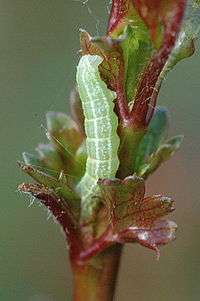Alsophila aescularia
| Alsophila aescularia | |
|---|---|
 | |
| Scientific classification | |
| Kingdom: | Animalia |
| Phylum: | Arthropoda |
| Class: | Insecta |
| Order: | Lepidoptera |
| Family: | Geometridae |
| Genus: | Alsophila |
| Species: | A. aescularia |
| Binomial name | |
| Alsophila aescularia Denis & Schiffermüller, 1775 | |
Alsophila aescularia, the March moth, is a moth of the family Geometridae. It is found throughout Europe and is a pest of fruit trees.


The female of this species is wingless. It is usually found resting on tree-trunks. The male has a distinctive way of resting with overlapping wings.The wings appear long and narrow in this position. The males are attracted to light.
The wingspan is 25–35 mm. The colour of the forewings varies between pale brownish and grayish brown. There is a well-defined Usually dark brown central band. The lines are sharply toothed and on the opposite side to the band they are whitish. A prominent black dot is present on the hind wings. Darkened specimens are rare. In these the lines are extinguished or the butterfly is completely black
The females have no wings. They are eight to ten millimeters long. The abdomen is brownish grey, the abdominal hair tuft is about two millimeters wide and thus narrower than the abdomen, which represents a differentiator against Alsophila aceraria.
The palps are very short, the sensors are slightly toothed. The proboscis is stunted. The tibiae of the hind legs have four spurs that are very short in females.
The bright pale-green larva reaches a length of about 26 millimeters. It is characterized by a very smooth skin and a flat head. There is a dark green dorsal line and yellowish-white lateral lines. In contrast to other geometrid caterpillars, they have an additional rudimentary abdominal leg pair in the fifth segment.
The adults are active in March and April .
The larva feeds on a range of trees. Malus domestica, Prunus domestica, Prunus domestica domestica,Prunus spinosa, Prunus padus, Cerasus, Tilia, Quercus robur, Quercus petraea, Quercus rubra,Acer campestris, Acer pseudoplatanus, Ulmus, Crataegus, Rosa canina, Ligustrum vulgare, Carpinus betulus, Fagus sylvatica Corylus arvellana, Fraxinus excelsior, Lonicera xylosteum, Rhamnus cathartica,Betula pendula.
Long, spider's-web like strings hang from oak trees in the southern hemisphere.The larvae hangs from one end.
References
External links
| Wikimedia Commons has media related to Alsophila aescularia. |
- Vlindernet (Dutch)
- Recente waarnemingen on waarneming.nl (Dutch)]
- Lepidoptera of Belgium
- March moth at UK Moths